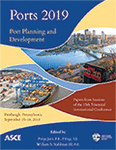15th Triennial International Conference
Analysis of Measured Marine Oil Terminal Berthing Velocities
Publication: Ports 2019: Port Planning and Development
ABSTRACT
Berthing velocities for design of fender systems have long been based on old and incomplete data, often from studies dating as far back as the 1950s. Both PIANC and MOTEMS continue to use values based on these old datasets in their recommendations and rules for fender design. PIANC MarCom Working Group 145, Berthing Velocities and Fender Design, has attempted to collect data from around the world to improve the empirical background behind the values used for design of modern fender systems. Although plenty of useful data has been collected, data from marine oil terminals has been especially difficult to come by, due to the proprietary nature of oil companies. The supporting ASCE COPRI Berthing Velocity Committee has attempted to obtain data from several marine oil terminals to specifically address the data gap for this type of facility. This paper will present the results of the analysis of several years’ worth of data from a Northern California oil terminal with allision avoidance systems (berthing velocity monitoring systems) installed in 2010 or later. The berthing velocities have been recorded for several hundred vessel arrivals, ranging from small barges with deadweights of 5,000 MT to tankers with deadweights of up to 190,000 MT. The data for these arrivals has been analyzed and compared to the values provided in the referenced documents, particularly the data from PIANC Working Group 145, with commentary on trends and other factors that might influence the collected data.
Get full access to this article
View all available purchase options and get full access to this chapter.
REFERENCES
ASCE (American Society of Civil Engineers). (2017) Minimum Design Loads and Associated Criteria for Buildings and Other Structures, Standard ASCE/SEI 7-16. ASCE, Reston, VA
ASCE (American Society of Civil Engineers). (2014) Seismic Design of Piers and Wharves, Standard ASCE/COPRI 61-14. ASCE, Reston, VA
Beckett Rankine, (2010) “Berthing Velocities and Brolsma’s Curves” 270 Vauxhall Bridge Road, Westminster, London
BSI (British Standards Institution) (2014) Maritime Works - Part 4: Code of Practice for Design of Fendering and Mooring Systems, BS 6349-4:2014
CBC (California Building Code) (2016) California Code of Regulations Title 24, Part 2, Volume 2, Chapter 31F, California Building Standards Commission, Sacramento, CA
Metzger, A. (2013) Characterizing the Load Environment of Washington State Ferry and Alaska Marine Highway Ferry Landings, WA-RD 804.1, Prepared for the Washington State Department of Transportation.
PIANC (International Navigation Association) (2002) Guidelines for the Design of Fenders Systems, MarCom WG-33. PIANC, Brussels, Belgium
Roubos, A., Peters, D.J., Groenewegen, L., Steenbergen, R., “Partial Safety Factors for Berthing Velocity and Loads on Marine Structure.” J. Marine Structures
UFC (Unified Facilities Criteria) (2017) Design: Piers and Wharves, UFC 4-152-01
Information & Authors
Information
Published In
Ports 2019: Port Planning and Development
Pages: 162 - 172
Editors: Pooja Jain, Moffatt & Nichol and William S. Stahlman III, America's Central Port
ISBN (Online): 978-0-7844-8262-9
Copyright
© 2019 American Society of Civil Engineers.
History
Published online: Sep 12, 2019
Published in print: Sep 12, 2019
Authors
Metrics & Citations
Metrics
Citations
Download citation
If you have the appropriate software installed, you can download article citation data to the citation manager of your choice. Simply select your manager software from the list below and click Download.
